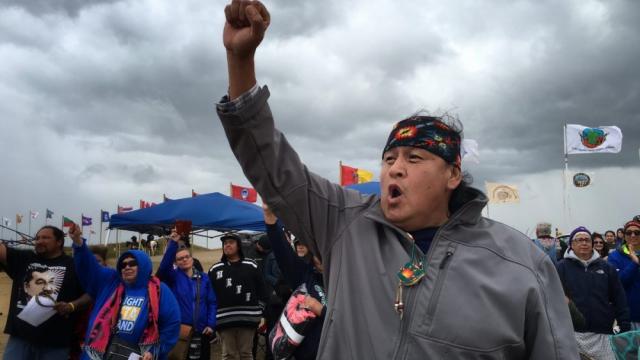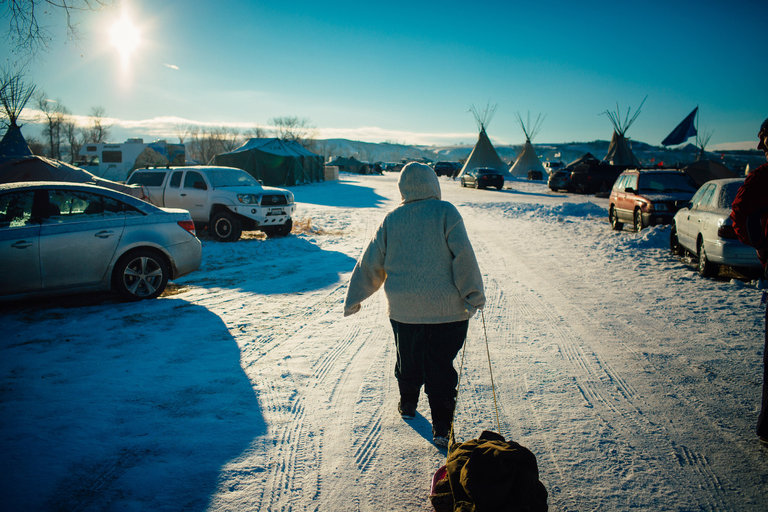
Construction of the controversial Dakota Access Pipeline was halted Sunday night after the U.S. Army Corps of Engineers denied an easement that would allow the pipeline to cross beneath Lake Oahe, threatening the water supply of the Standing Rock Indian Reservation downstream.
In a statement, the Army said it made the decision because the Sioux Tribe had repeatedly expressed concerns that the pipeline posed a risk to its water and treaty rights. “The best way to complete that work responsibly and expeditiously is to explore alternate routes for the pipeline crossing,” the statement reads.
The Standing Rock Sioux Tribe celebrated the decision on Sunday: “We wholeheartedly support the decision of the administration and commend with the utmost gratitude the courage it took on the part of President Obama, the Army Corps, the Department of Justice and the Department of the Interior to take steps to correct the course of history and to do the right thing,” Standing Rock Sioux Tribal Chairman Dave Archambault II said in a statement.
“The Standing Rock Sioux Tribe and all of Indian Country will be forever grateful to the Obama Administration for this historic decision.”
The announcement is being hailed as a major win for the Standing Rock encampment, which has opposed the construction of the pipeline under Lake Oahe because they fear it will leak into the water downstream. Protesters also worry ongoing construction would destroy the surrounding sacred burial sites.
“Instead, the Corps will be undertaking and environmental impact statement to look at possible alternative routes,” the Standing Rock Sioux Tribe said.
Construction of the pipeline was nearly complete, and the companies behind the project had prepared to drill under the lake, waiting only on the easement to proceed. The lake and the land, 200 meters on either side of it, is controlled by the Army Corps of Engineers, so the company needs its permission to drill underneath. In court affidavits, company representatives had sworn that they needed the pipeline completed by January 1, 2017 in order to fulfill contracts.
However, the companies filed U.S. federal court applications in mid-November, asking a judge to allow them to go around the Army Corps of Engineers and continue construction. “The declaratory relief Dakota Access Pipeline has sought seeks to end the Administration’s political interference in the Dakota Access Pipeline review process,” the company said in a statement.
The celebrations may be short-lived, however. President-elect Donald Trump takes office next year, and on Thursday his team said that he supports the pipeline project. The Sioux Tribe said Sunday it hopes the incoming administration respects the decision going forward.
The Standing Rock encampment began in the spring, growing from just a small cluster of tents to between 5,000 and 10,000 people, by some estimates. The encampment now resembles a densely-packed small town.
Over the weekend, the movement was bolstered by the arrival of thousands of allies and veterans, who said they would provide a “human shield” between police and protesters, who call themselves water protectors. In the last month, police have cracked down on protesters several times, hitting them with rubber bullets, tear gas and water cannons. But videos regularly shared on social media, along with the arrival of the veterans this weekend, have drawn mainstream media coverage of late, shining a spotlight on the resistance movement.
“We want to thank everyone who played a role in advocating for this cause,” the Sioux Tribe said. “We thank the tribal youth who initiated this movement. We thank the millions of people around the globe who expressed support for our cause. We thank the thousands of people who came to the camps to support us, and the tens of thousands who donated time, talent, and money to our efforts to stand against this pipeline in the name of protecting our water.
“We especially thank all of the other tribal nations and jurisdictions who stood in solidarity with us, and we stand ready to stand with you if and when your people are in need.”
3 WAYS TO SHOW YOUR SUPPORT
- Log in to post comments

















